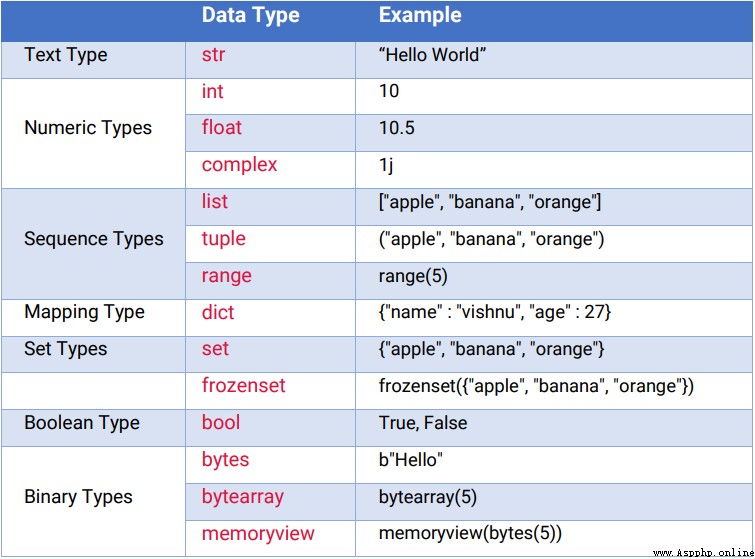Python在編程語言流行指數PYPL中已多次排名第一。
由於其代碼可讀性和更簡單的語法,它被認為是有史以來最簡單的語言。
NumPy、Pandas、TensorFlow等各種AI和機器學習庫的豐富性,是Python核心需求之一。
如果你是數據科學家或 AI/機器學習的初學者,那麼Python是開始你的旅程的正確選擇。
本次,小F會帶著大家探索一些Python編程的基礎知識,雖然簡單但都很有用。
目錄
數據類型
變量
列表
集合
字典
注釋
基本功能
條件語句
循環語句
函數
異常處理
字符串操作
正則表達式
▍1、數據類型
數據類型是可以存儲在變量中的數據規范。解釋器根據變量的類型為變量分配內存。
下面是Python中的各種數據類型。

▍2、變量
變量是存放數據值的容器。
變量可以使用短名稱(如x和y)或更具描述性的名稱(age、carname、total_volume)。
Python 變量命名規則:
變量名必須以字母或下劃線字符開頭
變量名稱不能以數字開頭
變量名只能包含字母數字字符和下劃線(A-z、0-9和_)
變量名稱區分大小寫(age、Age和AGE是三個不同的變量)
var1 = 'Hello World'
var2 = 16
_unuseful = 'Single use variables'輸出結果如下。

▍3、列表
列表(List)是一種有序和可更改的集合,允許重復的成員。
它可能不是同質的,我們可以創建一個包含不同數據類型(如整數、字符串和對象)的列表。
>>> companies = ["apple","google","tcs","accenture"]
>>> print(companies)
['apple', 'google', 'tcs', 'accenture']
>>> companies.append("infosys")
>>> print(companies)
['apple', 'google', 'tcs', 'accenture', 'infosys']
>>> print(len(companies))
5
>>> print(companies[2])
tcs
>>> print(companies[-2])
accenture
>>> print(companies[1:])
['google', 'tcs', 'accenture', 'infosys']
>>> print(companies[:1])
['apple']
>>> print(companies[1:3])
['google', 'tcs']
>>> companies.remove("infosys")
>>> print(companies)
["apple","google","tcs","accenture"]
>>> companies.pop()
>>> print(companies)
["apple","google","tcs"]▍4、集合
集合(Set)是一個無序和無索引的集合,沒有重復的成員。
對於從列表中刪除重復條目非常有用。它還支持各種數學運算,例如並集、交集和差分。
>>> set1 = {1,2,3,7,8,9,3,8,1}
>>> print(set1)
{1, 2, 3, 7, 8, 9}
>>> set1.add(5)
>>> set1.remove(9)
>>> print(set1)
{1, 2, 3, 5, 7, 8}
>>> set2 = {1,2,6,4,2}
>>> print(set2)
{1, 2, 4, 6}
>>> print(set1.union(set2)) # set1 | set2
{1, 2, 3, 4, 5, 6, 7, 8}
>>> print(set1.intersection(set2)) # set1 & set2
{1, 2}
>>> print(set1.difference(set2)) # set1 - set2
{8, 3, 5, 7}
>>> print(set2.difference(set1)) # set2 - set1
{4, 6}▍5、字典
字典是作為鍵值對的可變無序項集合。
與其他數據類型不同,它以【鍵:值】對格式保存數據,而不是存儲單個數據。此功能使其成為映射JSON響應的最佳數據結構。
>>> # example 1
>>> user = { 'username': 'Fan', 'age': 20, 'mail_id': '[email protected]', 'phone': '18650886088' }
>>> print(user)
{'mail_id': '[email protected]', 'age': 20, 'username': 'Fan', 'phone': '18650886088'}
>>> print(user['age'])
20
>>> for key in user.keys():
>>> print(key)
mail_id
age
username
phone
>>> for value in user.values():
>>> print(value)
[email protected]
20
Fan
18650886088
>>> for item in user.items():
>>> print(item)
('mail_id', '[email protected]')
('age', 20)
('username', 'Fan')
('phone', '18650886088')
>>> # example 2
>>> user = {
>>> 'username': "Fan",
>>> 'social_media': [
>>> {
>>> 'name': "Linkedin",
>>> 'url': "https://www.linkedin.com/in/codemaker2022"
>>> },
>>> {
>>> 'name': "Github",
>>> 'url': "https://github.com/codemaker2022"
>>> },
>>> {
>>> 'name': "QQ",
>>> 'url': "https://codemaker2022.qq.com"
>>> }
>>> ],
>>> 'contact': [
>>> {
>>> 'mail': [
>>> "[email protected]",
>>> "[email protected]"
>>> ],
>>> 'phone': "18650886088"
>>> }
>>> ]
>>> }
>>> print(user)
{'username': 'Fan', 'social_media': [{'url': 'https://www.linkedin.com/in/codemaker2022', 'name': 'Linkedin'}, {'url': 'https://github.com/codemaker2022', 'name': 'Github'}, {'url': 'https://codemaker2022.qq.com', 'name': 'QQ'}], 'contact': [{'phone': '18650886088', 'mail': ['[email protected]', '[email protected]']}]}
>>> print(user['social_media'][0]['url'])
https://www.linkedin.com/in/codemaker2022
>>> print(user['contact'])
[{'phone': '18650886088', 'mail': ['[email protected]', '[email protected]']}]▍6、注釋
單行注釋,以井字符(#)開頭,後面帶有消息並在行尾結束。
# 定義用戶年齡
age = 27
dob = '16/12/1994' # 定義用戶生日多行注釋,用特殊引號(""")括起來,你可以將消息放在多行中。
"""
Python小常識
This is a multi line comment
"""▍7、基本功能
print()函數在控制台中打印提供的消息。此外你還可以提供文件或緩沖區輸入作為在屏幕上打印的參數。
print(object(s), sep=separator, end=end, file=file, flush=flush)
print("Hello World") # prints Hello World
print("Hello", "World") # prints Hello World?
x = ("AA", "BB", "CC")
print(x) # prints ('AA', 'BB', 'CC')
print("Hello", "World", sep="---") # prints Hello---Worldinput()函數用於收集來自控制台的用戶輸入 。
這裡需要注意,input()會把你輸入的任何內容轉換為字符串。
因此,如果你將年齡作為整數值提供,但input()方法將其作為字符串返回,此時就需要手動將其轉換為整數。
>>> name = input("Enter your name: ")
Enter your name: Codemaker
>>> print("Hello", name)
Hello Codemakerlen()可以查看對象的長度。如果你輸入一個字符串,則可以獲取指定字符串中的字符數。
>>> str1 = "Hello World"
>>> print("The length of the string is ", len(str1))
The length of the string is 11str()用於將其他數據類型轉換為字符串值。
>>> str(123)
123
>>> str(3.14)
3.14int()用於將字符串轉換為整數。
>>> int("123")
123
>>> int(3.14)
3▍8、條件語句
條件語句是用於根據特定條件更改程序流程的代碼塊。這些語句只有在滿足特定條件時才會執行。
在Python中,我們使用if,if-else,循環(for,while)作為條件語句根據某些條件來改變程序的流程。
if-else語句。
>>> num = 5
>>> if (num > 0):
>>> print("Positive integer")
>>> else:
>>> print("Negative integer")elif語句。
>>> name = 'admin'
>>> if name == 'User1':
>>> print('Only read access')
>>> elif name == 'admin':
>>> print('Having read and write access')
>>> else:
>>> print('Invalid user')
Having read and write access▍9、循環語句
循環是一個條件語句,用於重復某些語句(在其主體中),直到滿足某個條件。
在Python中,我們通常使用for和while循環。
for循環。
>>> # loop through a list
>>> companies = ["apple", "google", "tcs"]
>>> for x in companies:
>>> print(x)
apple
google
tcs
>>> # loop through string
>>> for x in "TCS":
>>> print(x)
T
C
Srange()函數返回一個數字序列,它可以用作for循環控制。
它基本上需要三個參數,其中第二個和第三個是可選的。參數是開始值、停止值和步進數。步進數是每次迭代循環變量的增量值。
>>> # loop with range() function
>>> for x in range(5):
>>> print(x)
0
1
2
3
4
>>> for x in range(2, 5):
>>> print(x)
2
3
4
>>> for x in range(2, 10, 3):
>>> print(x)
2
5
8我們還可以使用else關鍵字在循環結束時執行一些語句。
在循環結束時提供else語句以及循環結束時需要執行的語句。
>>> for x in range(5):
>>> print(x)
>>> else:
>>> print("finished")
0
1
2
3
4
finishedwhile循環。
>>> count = 0
>>> while (count < 5):
>>> print(count)
>>> count = count + 1
0
1
2
3
4我們可以在while循環的末尾使用else,類似於for循環,當條件為假時執行一些語句。
>>> count = 0
>>> while (count < 5):
>>> print(count)
>>> count = count + 1
>>> else:
>>> print("Count is greater than 4")
0
1
2
3
4
Count is greater than 4▍10、函數
函數是用於執行任務的可重用代碼塊。在代碼中實現模塊化並使代碼可重用,這是非常有用的。
>>> # This prints a passed string into this function
>>> def display(str):
>>> print(str)
>>> return
>>> display("Hello World")
Hello World▍11、異常處理
即使語句在語法上是正確的,它也可能在執行時發生錯誤。這些類型的錯誤稱為異常。我們可以使用異常處理機制來避免此類問題。
在Python中,我們使用try,except和finally關鍵字在代碼中實現異常處理。
>>> def divider(num1, num2):
>>> try:
>>> return num1 / num2
>>> except ZeroDivisionError as e:
>>> print('Error: Invalid argument: {}'.format(e))
>>> finally:
>>> print("finished")
>>>
>>> print(divider(2,1))
>>> print(divider(2,0))
finished
2.0
Error: Invalid argument: division by zero
finished
None▍12、字符串操作
字符串是用單引號或雙引號(',")括起來的字符集合。
我們可以使用內置方法對字符串執行各種操作,如連接、切片、修剪、反轉、大小寫更改和格式化,如split()、lower()、upper()、endswith()、join()和ljust()、rjust()、format()。
>>> msg = 'Hello World'
>>> print(msg)
Hello World
>>> print(msg[1])
e
>>> print(msg[-1])
d
>>> print(msg[:1])
H
>>> print(msg[1:])
ello World
>>> print(msg[:-1])
Hello Worl
>>> print(msg[::-1])
dlroW olleH
>>> print(msg[1:5])
ello
>>> print(msg.upper())
HELLO WORLD
>>> print(msg.lower())
hello world
>>> print(msg.startswith('Hello'))
True
>>> print(msg.endswith('World'))
True
>>> print(', '.join(['Hello', 'World', '2022']))
Hello, World, 2022
>>> print(' '.join(['Hello', 'World', '2022']))
Hello World 2022
>>> print("Hello World 2022".split())
['Hello', 'World', '2022']
>>> print("Hello World 2022".rjust(25, '-'))
---------Hello World 2022
>>> print("Hello World 2022".ljust(25, '*'))
Hello World 2022*********
>>> print("Hello World 2022".center(25, '#'))
#####Hello World 2022####
>>> name = "Codemaker"
>>> print("Hello %s" % name)
Hello Codemaker
>>> print("Hello {}".format(name))
Hello Codemaker
>>> print("Hello {0}{1}".format(name, "2022"))
Hello Codemaker2022▍13、正則表達式
導入regex模塊,import re。
re.compile()使用該函數創建一個Regex對象。
將搜索字符串傳遞給search()方法。
調用group()方法返回匹配的文本。
>>> import re
>>> phone_num_regex = re.compile(r'\d\d\d-\d\d\d-\d\d\d\d')
>>> mob = phone_num_regex.search('My number is 996-190-7453.')
>>> print('Phone number found: {}'.format(mob.group()))
Phone number found: 996-190-7453
>>> phone_num_regex = re.compile(r'^\d+$')
>>> is_valid = phone_num_regex.search('+919961907453.') is None
>>> print(is_valid)
True
>>> at_regex = re.compile(r'.at')
>>> strs = at_regex.findall('The cat in the hat sat on the mat.')
>>> print(strs)
['cat', 'hat', 'sat', 'mat']好了,本期的分享就到此結束了,有興趣的小伙伴可以自行去實踐學習。
-------- End --------

圖解Pandas-圖文01-數據結構介紹
圖解Pandas-圖文02-創建數據對象
圖解Pandas-圖文03-讀取和存儲Excel文件
圖解Pandas-圖文04-常見的數據訪問
圖解Pandas-圖文05-常見的數據運算
圖解Pandas-圖文06-常見的數學計算
圖解Pandas-圖文07-常見的數據統計
圖解Pandas-圖文08-常見的數據篩選

